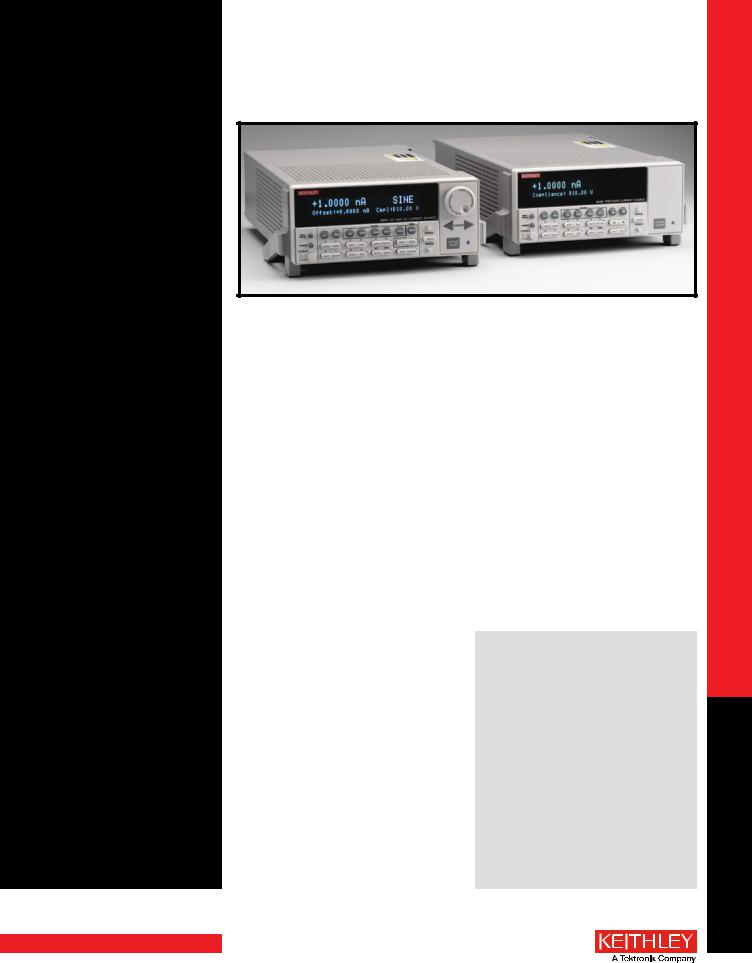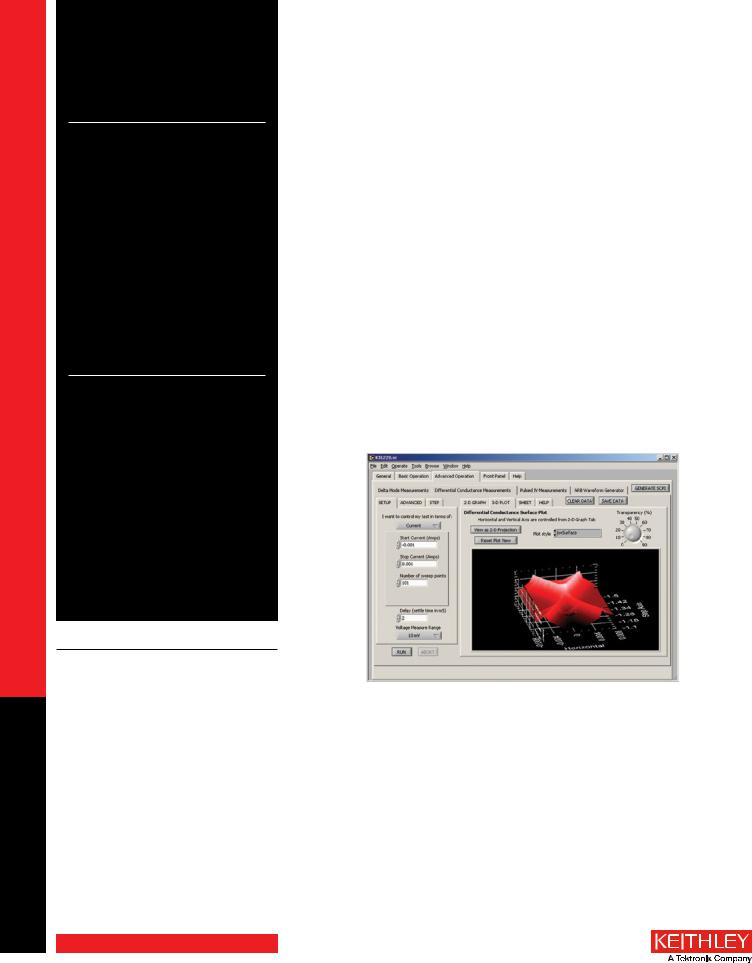Atec 6220, 6221 User Manual

6220
6221
DC Current Source
AC and DC Current Source
6220 and 6221
•Source and sink (programmable load) 100fA to 100mA
•1014Ω output impedance ensures stable current sourcing into variable loads
•65000-point source memory allows executing comprehensive test current sweeps directly from the current source
•Built-in RS-232, GPIB, Trigger Link, and digital I/O interfaces
•Reconfigurable triax output simplifies matching the application’s guarding requirements
•Model 220 emulation mode eliminates need to reprogram existing applications
6221 Only
•Source AC currents from 4pA to 210mA peak to peak for AC characterization of components and materials. The 6221’s 10MHz output update rate generates smooth sine waves up to 100kHz
•Built-in standard and arbitrary waveform generators with 1mHz to 100kHz frequency range. Applications include use as a complex programmable load or sensor signal and for noise emulation
•Programmable pulse widths as short as 5µs, limiting power dissipation in delicate com ponents. Supports pulsed I-V measurements down to 50µs when used with Model 2182A Nanovoltmeter
•Built-in Ethernet interface for easy remote control without a GPIB controller card
1.888.KEITHLEY (U.S. only) www.keithley.com
The Model 6220 DC Current Source and Model 6221 AC and DC Current Source combine ease of use with exceptionally low current noise.. Low current sourcing is critical to applications in test environments ranging from R&D to production, especially in the semiconductor, nanotechnology, and superconductor industries.. High sourcing accuracy and built-in control functions make the Models 6220 and 6221 ideal for applications like Hall measurements, resistance measurements using delta mode, pulsed measurements, and differential conductance measurements..
The need for precision, low current sourcing. Device testing and characterization for today’s very small and power-efficient electronics requires sourcing low current levels, which demands the use of a precision, low current source.. Lower stimulus currents produce lower—and harder to measure— voltages across the device.. Combining the Model 6220 or 6221 with a Model 2182A Nanovoltmeter makes it possible to address both of these challenges..
AC current source and current source waveform generator. The Model 6221 is the only low current AC source on the market.. Before its introduction, researchers and engineers were forced to build their own AC current sources.. This cost-effective source provides better accuracy, consistency, reliability, and robustness than “home-made” solutions.. The Model 6221 is also the only commercially available current source waveform generator, which greatly simplifies creating and outputting complex waveforms..
Simple programming. Both current sources are fully programmable via the front panel controls or from an external controller via RS-232 or GPIB interfaces; the Model 6221 also features an Ethernet interface for remote control from anywhere there’s an Ethernet connection.. Both instruments can source DC currents from 100fA to 105mA; the Model 6221 can also source AC currents from 4pA to 210mA peak to peak.. The output voltage compliance of either source can be set from 0..1V to 105V in 10mV steps.. Voltage compliance (which limits
the amount of voltage applied when sourcing a current) is critical for applications in which overvoltages could damage the device under test (DUT)..
Drop-in replacement for the Model 220 current source. These instruments build upon Keithley’s popular Model 220 Programmable Current Source; a Model 220 emulation mode makes it easy to replace a Model 220 with a Model 6220/6221 in an existing application without rewriting the control code..
Define and execute current ramps easily.
Both the Models 6220 and 6221 offer tools for defining current ramps and stepping through predefined sequences of up to 65,536 output values using a trigger or a timer.. Both sources support linear, logarithmic, and custom sweeps..
Precision low current sourcing
LOW LEVEL MEASURE & SOURCE
A Greater Measure of Confidence

6220
6221
DC Current Source
AC and DC Current Source
Precision low current sourcing
LOW LEVEL MEASURE & SOURCE
Ordering Information
6220 DC Precision Current Source
6221 AC and DC Current Source
6220/2182A
Complete Delta Mode System, w/DC Current Source, Nanovoltmeter, and all necessary cables (GPIB cables not included)
6221/2182A
Complete Delta Mode System, w/AC and DC Current Source, Nanovolt meter, and all necessary cables (GPIB cables
not included)
Accessories Supplied
237-AlG-2 6.6 ft (2m), Low Noise, Input Cable with Triax- to-Alligator Clips
8501-2 6.6 ft (2m) Trigger Link Cable to connect 622x to 2182A
CA-180-3A Ethernet Crossover Cable (6221 only)
CA-351 Communication Cable between 2182A and 622x
CS-1195-2 safety Interlock Connector
Instruction manual on CD
Getting Started manual (hardcopy) Software (downloadable)
AccessoriEs Available
7006-* GPIB Cable with Straight-On Connector 7007-1 Shielded IEEE-488 Cable, 1m (3..3 ft) 7007-2 Shielded IEEE-488 Cable, 2m (6..6 ft)
7078-TRX-5 5 ft (1..5m), Low Noise, Triax-to-Triax Cable (Male on Both Ends)
KPCI-488LPA IEEE-488 Interface/Controller for the PCI Bus KUSB-488B IEEE-488 USB-to-GPIB Interface Adapter
|
Services Available |
6220-3Y-EW |
1-year factory warranty extended to 3 years from |
|
date of shipment |
6221-3Y-EW |
1-year factory warranty extended to 3 years from |
|
date of shipment |
C/6220-3Y-ISO 3 (ISO-17025 accredited) calibrations within 3 years of purchase*
C/6221-3Y-ISO 3 (ISO-17025 accredited) calibrations within 3 years of purchase*
*Not available in all countries
1.888.KEITHLEY (U.S. only) www.keithley.com
The Model 6221’s combination of high source resolution and megahertz update rates makes it capable of emulating high fidelity current signals that are indistinguishable from analog current ramps..
Free Instrument Control Example Start-up Software
The instrument control example software available for the sources simplifies both performing basic sourcing tasks and coordinating complex measurement functions with the Keithley Model 2182A.. The software, developed in the LabVIEW® programming environment, includes a step-by-step measurement guide that helps users set up their instruments and make proper connections, as well as program basic sourcing functions.. The advanced tools in the package support delta mode, differential conductance, and pulse mode measurements.. From this package, users can print out the instrument commands for any of the pre-programmed functions, which provides a starting point for incorporating these functions into customized applications..
Differential Conductance
Differential conductance measurements are among the most important and critical measurements made on non-linear tunneling devices and on low temperature devices.. Mathematically, differential conductance is the derivative of a device’s I-V curve.. The Model 6220 or 6221, combined with the Model 2182A Nanovoltmeter, is the industry’s most complete solution for differential conductance measurements.. Together, these instruments are also the fastest solution available, providing 10× the speed and significantly lower noise than other options.. Data can be obtained in a single measurement pass, rather than by averaging the result of multiple sweeps, which is both time-consuming and prone to error.. The Model 622X and Model 2182A are also easy to use because the combination can be treated as a single instrument.. Their simple connections eliminate the isolation and noise current problems that plague other solutions..
Figure 1. Perform, analyze, and display differential conductance measurements.
Delta Mode
Keithley originally developed the delta mode method for making low noise measurements of voltages and resistances for use with the Model 2182 Nanovoltmeter and a triggerable external current source.. Essentially, the delta mode automatically triggers the current source to alternate the signal polarity, then triggers a nanovoltmeter reading at each polarity.. This current reversal technique cancels out any constant thermoelectric offsets, ensuring the results reflect the true value of the voltage..
This same basic technique has been incorporated into the Model 622X and Model 2182A delta mode, but its implementation has been dramatically enhanced and simplified.. The technique can now cancel thermoelectric offsets that drift over time, produce results in half the time of the previous technique, and allow the source to control and configure the nanovoltmeter, so setting up the measurement takes just two key presses.. The improved cancellation and higher reading rate reduces measurement noise to as little as 1nV..
A Greater Measure of Confidence
